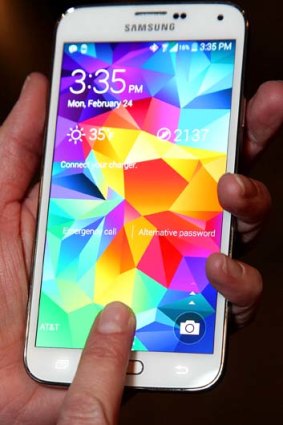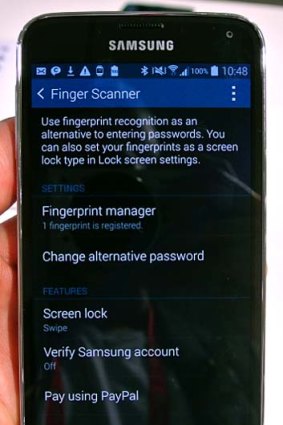By Liam Tung
Going against expectations, Samsung didn't overhaul the design, look and feel of its new flagship smartphone, the Galaxy S5, instead going for modest tweaks and two new sensors aimed at making it the keys and eyes to your life.
While Samsung has typically out-specced its rivals, the new Galaxy S5 appears to be aimed at outsmarting them instead. Whether it's enough to make consumers jump at what's likely to be a pricey device is another matter, with few visible differences between its new flagship and its feature packed predecessor, the Galaxy S4.
The South Korean tech giant's Galaxy Note devices already offer consumers a bevy of choices in the larger phablet category, so Samsung didn't need to push the limits of size for its Android 4.4.2 KitKat-based S5, which has a marginally larger 5.1-inch display than the S4's 5-inch display.
At a glance, it's quite difficult to see any changes between the S4 and S5, which shares the same basic shape and physical design, such as the curved frame coupled with shiny metal edging and the usual oval home button. While the S5 remains fairly comfortable and light in the hand, Samsung failed to make the S5 lighter or slimmer. At 145 grams and 8.1 millimetres thin, it's 15 grams heavier than the S4 and surprisingly 0.2 millimetres thicker.

Using the Galaxy S5's fingerprint scanner.
Some fans had hoped Samsung would follow HTC's and Apple's lead in using full-metal jackets to give their premium devices a sleeker feel. Apple managed to increase the size of the display on its iPhone 5s while making it lighter at the same time, weighing in at 112 grams. To achieve a more luxury feel, Samsung simply made the plastic back plate perforated. It's still removable, which means the battery can be replaced.
There were rumours Samsung would pack the S5 with a new super high resolution "2K" display but there's actually no change here. Like the S4, it's got a full HD Super AMOLED display at 1920x1080 resolution, which still offers the clear, detailed and crisp images one expects from a premium phone.
Apps should be slightly faster with the new 2.5 gigahertz (GHz) quad core processor, up from 1.9 GHz in the S4, while the rear-facing camera has been boosted to 16 megapixels (MP) compared with the S4's 13 MP camera. As expected, the S5 also supports Australia's 4G networks.
But the device can't be judged on specs alone.

Setting up the fingerprint scanner on the Galaxy S5.
"We did a global survey of consumers to really understand what they wanted from their phones," Arno Lenior, chief marketing officer for Samsung Australia, told Fairfax Media. "There are some dramatic improvements to the hardware, but it's how people are using their phones and what's important to them."
He pointed to the S5's dust and water resistance, which was achieved by covering internal components and the earphone jack in silicon, while the power jack has a new cover.
A nifty new power-saving mode will be handy where there's limited chance to recharge, such as at a festival or conference. It could also compensate for the battery only being boosted from 2600mAh to 2800mAh.
Activating power-saving mode dims the display and reduces it to black and white, limiting access to only a few key apps, such as email, phone and web browser. Samsung claims it could give the device three to eight days of life without charging.
The camera also has some impressive software improvements. It's always annoying missing a moment as the camera fumbles over focus, which the S5 overcomes with its lightning-fast auto-focus. Samsung claims this happens in 0.3 seconds and though difficult to measure, a few test snapshots in a well-lit room did work as claimed.
Another camera feature that helps improve the quality of photos is the selective focus, which takes two pictures – one each of the foreground and background – and allows you to select where you want the photo to focus.
The Galaxy S5 also introduced two new sensors that give it potential as a tool to authorise payments and as a health monitor.
Samsung's fingerprint scanner is similar to Apple's iPhone 5s TouchID, but instead of a light press on the home button, you swipe down from the bottom of the screen to the home button. The feature is only enabled after the user registers up to three fingerprints on the device. The idea is to replace passwords and pass codes for payments or to unlock services. The scanner seemed to work well on the devices displayed at Mobile World Congress, but it will be interesting to see whether troubles emerge, as they did for Apple's iPhone 5s, once the S5 is in the rough and tumble of every day use by millions of consumers.
Cleverly though, Samsung partnered with PayPal to launch its fingerprint scanner, giving it potential in a broader purchasing ecosystem than Apple's, which so far only allows payments in Apple's App Store and iTunes.
Samsung's fingerprint scanner also allows owners to unlock apps protected by Knox, the security system Samsung hopes will be its doorway to more enterprise users.
The other sensor – a heart-rate monitor nestled below the rear camera – has more questionable value, but it fits the health theme of Samsung's new Gear Fit fitness band, which launched alongside the S5.
Samsung's first attempt at wearable gadgets was widely deemed a failure by observers and launched only with the Galaxy Note 3, while support for other devices stumbled with delayed software updates. The new line of Gear 2 smart watches and Gear Fit may stand a better chance being integrated with the Galaxy S5 from the outset.
Despite an earlier unveiling than last year, the Galaxy S5 will be available to consumers in Australia at roughly the same time as last year's S4, with all major telcos offering the device from April. A retail price and subsidised plans have yet to be released.
Is Samsung's Galaxy S5 worth upgrading? Let us know in the comments.
The Sweden-based writer travelled to Barcelona as a guest of SAP.